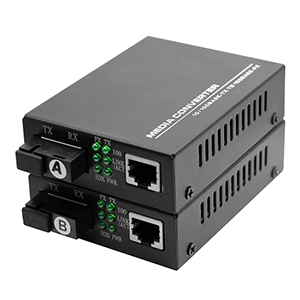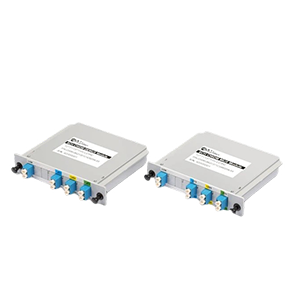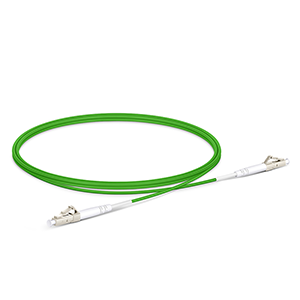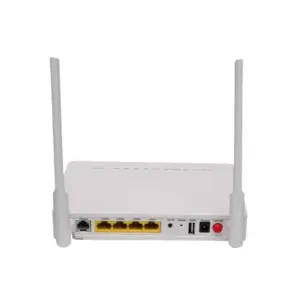Hello everyone! As a key component of network equipment integration, media converters play an important role in achieving seamless connections between different transmission media. How to correctly connect media converters to core network equipment such as switches is the key to ensuring smooth operation of the network. Today gracyfiber is pleased to introduce this process to you in detail, including preparations, connection steps, verification and troubleshooting, etc. We hope to help you better master the integration method of media converters and switches, and improve the flexibility and flexibility of the network. reliability.
Basic overview of media converters
Let me introduce the basics of media converters:
Media converter functions and types:
- A media converter is a network device used to connect and convert different types of network transmission media.
- It can realize interconnection and conversion between different network media such as fiber to copper, 10/100Mbps to Gigabit Ethernet, etc.
- Common media converter types include fiber to copper converters, Ethernet to POF converters, etc.
Common media converter interface standards:
- Media converters usually use standard Ethernet interfaces, such as RJ-45 or SFP/SFP+.
- On the fiber side, the media converter can support common fiber interfaces such as LC, SC, and ST.
- Some dedicated media converters can also support special optical fiber interfaces such as MTRJ and VF-45.
- The interface type of the converter needs to match the network equipment and transmission medium.
The importance of media converters in network device integration:
- Media converters can realize interconnection and communication between different network devices, making up for the differences in physical interfaces.
- In the process of network upgrade or heterogeneous device integration, media converters play a key intermediate conversion role.
- It enables devices with different network interfaces to be seamlessly connected, improving the flexibility and interoperability of the network.
- Rational use of media converters can reduce the cost of network transformation and extend the service life of existing equipment.
In general, media converters are an important bridge to interconnect heterogeneous network devices and play an irreplaceable role in network integration and upgrades. Network administrators need to have a deep understanding of the characteristics of different types of media converters and make reasonable choices to meet actual network needs.
Prepare to connect media converters and switches
Let me give you a detailed introduction to the preparations you need to pay attention to when connecting media converters and switches:
Check the port type of the switch and media converter:
- First you need to confirm whether the port types available on the switch and media converter match.
- Check whether the switch’s ports are RJ-45, SFP, SFP+, or other types.
- Also confirm the interface type supported by the media converter, such as fiber optic LC, SC, or copper wire RJ-45.
- Mismatching port types will result in incorrect connection, and you need to select an appropriate transfer device.
How to choose the right connection cable:
- If both the switch and media converter use RJ-45 cable interfaces, you can use standard Ethernet cables.
- If one end is an optical fiber interface, the corresponding optical fiber jumper (such as LC-LC, SC-SC) needs to be used for connection.
- The length of the optical fiber jumper should be selected according to the actual deployment environment to ensure transmission quality.
- The model and quality of the cable will also affect the overall network performance, so you need to choose carefully.
Confirm power supply to media converters and switches:
- Check whether the media converter requires a separate power supply or can be powered via the switch port (PoE).
- If the media converter requires a separate power supply, ensure that the power supply specifications match the converter requirements.
- For media converters that can be powered through the switch port, ensure that the switch port supports the required PoE standard.
- Insufficient power supply will cause the media converter to fail to work properly and needs to be confirmed in advance.
Example:
The switch port is SFP+ and the media converter is fiber optic to RJ-45. You need to prepare an LC-LC optical fiber jumper for connection. Also confirm whether the media converter requires an independent power supply. In short, when preparing to connect media converters and switches, it is necessary to comprehensively consider factors such as interface type matching, cable selection, and power supply to ensure that the entire network equipment can be reliably interconnected.
Steps to connect media converter and switch
Next, I will give you a detailed introduction to the specific steps for connecting the media converter and switch:
Use the correct connection cable to connect the media converter to the switch:
- Select the appropriate fiber optic jumper or Ethernet cable based on the interface type confirmed previously.
- Connect one end of the cable to the corresponding port on the media converter, and the other end to the corresponding port on the switch.
- For fiber optic connections, ensure the insertion and extraction direction and alignment of the fiber optic connector are correct.
- For Ethernet cable connections, pay attention to the use scenarios of straight-through cables or crossover cables.
Check whether the connection is secure and confirm that the indicator light is working properly:
- Check carefully whether the cable connector is fully inserted and fastened to avoid poor contact.
- Observe the lights on the media converter and switch to confirm that the connection is good.
- The indicator light may have different status indicators such as Link, Act, Speed, etc., please judge according to the instructions.
- If the indicator light displays abnormally, you may need to check the cable or rewire it.
Configuring settings for media converters and switches:
- Log in to the switch CLI and check whether the port’s speed and duplex mode are configured correctly.
- If port auto-negotiation fails, you can manually set the port speed and duplex.
- For the media converter, you may also need to configure some parameters, such as MDI/MDIX mode, etc.
- Ensure that the media converter and switch port configurations match correctly.
Example:Connect the SFP+ to RJ-45 media converter to the switch’s SFP+ port:
- Use LC-LC fiber optic patch cords to connect the fiber optic port of the media converter to the SFP+ port of the switch.
- Check whether the optical fiber connector is fully inserted and whether the indicator light shows normal connection status.
- Log in to the switch CLI and check whether the SFP+ port configuration is set to auto-negotiation or 1000Mbps full-duplex.
- If necessary, you can also set some parameters on the media converter to ensure that it matches the switch port.
Through the above steps, you can complete the correct connection and configuration of the media converter and switch to ensure that the two can communicate smoothly.
How to verify connectivity between media converter and switch
After completing the connection and configuration of the media converter and switch, the next step is to verify connectivity between them. Let me introduce you to the verification steps in detail:
Test connectivity using the ping command:
- Log in to the switch CLI and try to ping the network segment or device where the media converter is located.
- If ping returns successfully, the network connection is normal.
- If ping fails, further troubleshooting of network or device configuration issues is required.
Observe the status indicators of the switch and media converter:
- Check the various indicators on the switch port and media converter, such as Link, Act, Speed, etc.
- Normal display of the indicator light indicates that the physical connection is in good condition.
- If the indicator light is abnormal, there may be a problem with the device or cable.
Check the traffic transmission between network devices:
- Log in to the switch CLI and use the show interface command to view the traffic statistics of the port.
- Check the port’s throughput, error count and other indicators to confirm that data can be transmitted normally.
- If abnormal traffic is found, it may be necessary to further troubleshoot the configuration of the media converter or switch.
Example:
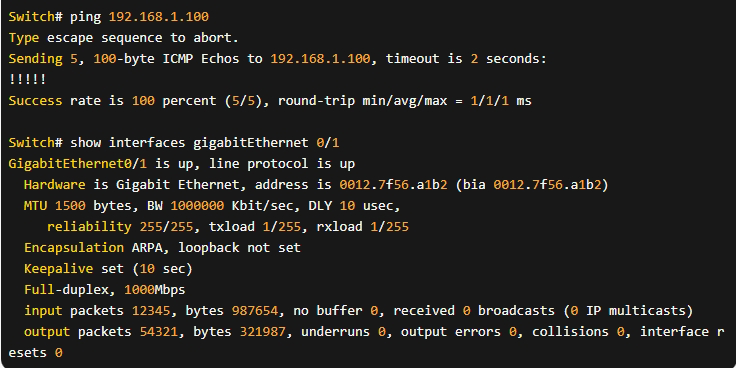
Through the above method, the connectivity between the media converter and the switch can be fully verified to ensure that they can communicate and transmit data normally. If any problems are found, they need to be further investigated and resolved.
How to troubleshoot and solve some common problems
Let me summarize for you the common problems and solutions you may encounter when using media converters:
Possible reasons for connection failure:
- Interface type mismatch: Check whether the media converter and switch ports use the same interface type.
- Improper cable selection: Make sure you are using the correct fiber optic patch cord or Ethernet cable.
- Power supply problem: Check whether the media converter is receiving sufficient power supply.
- Incorrect device configuration: Verify that the speed and duplex mode settings of the switch and media converter ports are correct.
Methods and suggestions for diagnosing and solving problems:
- Use the ping command to test the connectivity between the two devices and troubleshoot network-level connection problems.
- Observe the status indicator lights on the device to determine the connection status at the physical level.
- Check whether the cable is intact and try to replace the cable for testing.
- Log in to the device CLI, check whether the port configuration matches, and make adjustments if necessary.
- If the problem persists, you can try restarting the media converter and switch.
Tips for optimizing the use of media converters in real network deployments:
- Plan the network topology and connection requirements in advance, and choose the appropriate media converter type.
- Adopts a modular design and uses pluggable media converter modules to facilitate future expansion and replacement.
- Consider using a media converter with monitoring and management functions to facilitate centralized management and troubleshooting.
- Use redundant media converter connections for key equipment to improve network reliability.
- Develop a regular inspection and maintenance plan to ensure long-term stable operation of the media converter.
Example:If you find that the connection between the switch and the media converter fails, you can follow the following steps to troubleshoot and solve the problem:
- Check whether the interface types of the switch and media converter match, and whether the cables are connected correctly.
- Log in to the switch CLI and use the show interface command to view the port status and statistics.
- Try to ping the network segment where the media converter is located to confirm network-level connectivity.
- If the indicator light is abnormal, replace the cable or restart the device test.
- Check whether the speed and duplex configuration of the switch and media converter are consistent.
- If the problem persists, the media converter device may need to be replaced.
From the above, it is not difficult to see that when using a media converter, it is necessary to comprehensively consider all factors and take systematic diagnosis and solution measures to ensure that network devices can reliably connect and communicate with each other.
Summary
Properly connecting the media converter to the switch is a prerequisite for ensuring smooth communication between network devices. Before connecting, you need to carefully check the port types and power supply conditions of both parties and choose the appropriate connection cable. During the actual connection process, be sure to pay attention to the firmness of the wiring and make the necessary configuration settings.
You can ensure that the interaction between the media converter and the switch is functioning properly by verifying connectivity and troubleshooting possible issues. Our professional technical team is ready to provide you with a full range of media converter application support. If you have any questions during the connection or troubleshooting process, please feel free to contact us for communication.
How to connect a media converter to a switch FAQ
A media converter is a device that allows you to connect different types of network media, such as fiber optic and copper Ethernet, by converting the signals between them.
You may need to use a media converter when you have network devices with incompatible physical media interfaces, such as a switch with copper Ethernet ports and a device with fiber optic ports.
The most common media converters used with switches are fiber optic to copper converters, which allow you to connect fiber optic cables to copper-based Ethernet ports.
Typically, you would connect the media converter to the switch’s Ethernet port using an appropriate cable (e.g., copper Ethernet cable) and then connect the fiber optic cable to the media converter’s fiber optic port.
Yes, you may need to configure both the media converter and the switch port to ensure proper operation. This may involve setting the correct speed, duplex, and other settings on both devices.
On the switch side, you may need to configure the port to match the media converter’s settings, such as enabling the port, setting the speed and duplex mode, and potentially enabling features like auto-negotiation.
Media converters typically have their own power supply or may be powered through the Ethernet port using Power over Ethernet (PoE) if supported by the switch.
The maximum distance between the media converter and the switch will depend on the cable type and quality, as well as the specific media converter and switch capabilities.
Troubleshooting steps may include verifying the physical connections, checking the configuration on both devices, testing the fiber optic or copper cabling, and ensuring compatibility between the media converter and the switch.
Best practices include using Cisco-approved or manufacturer-recommended media converters, following the manufacturer’s installation and configuration guidelines, and regularly monitoring the connections for any issues.

